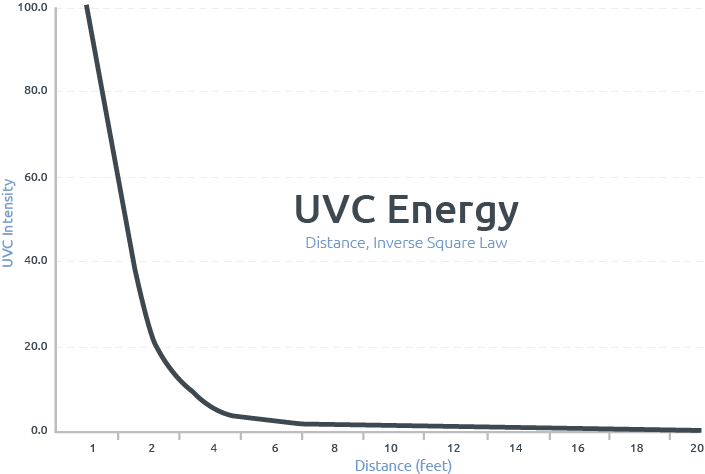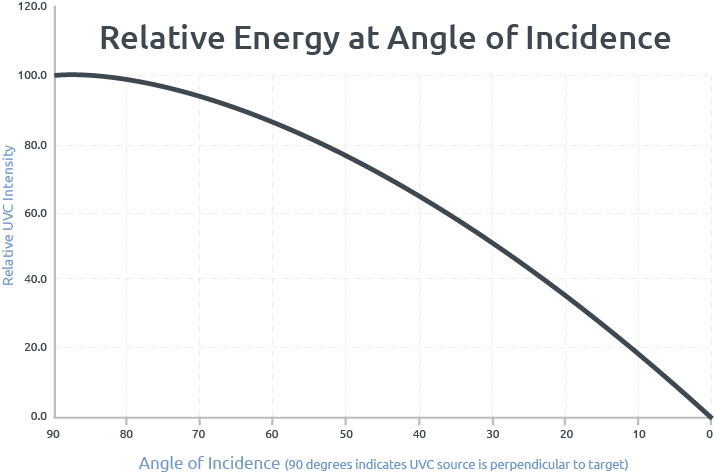Ultraviolet energy is an electromagnetic wave that is generated by excited mercury vapor. The fluorescent bulbs above your head are of the same nature except bulbs designed for generating visible light employ different glass in the construction of the bulb, and a fluorescing powder coats the surface inside the visible light generating bulb. The bulbs used in Diversey MoonBeam3 contain less mercury than typical overhead lamps and, unlike overhead lamps, our bulbs generate very little visible light – but pack a serious, invisible UVC punch.
MoonBeam3 delivers powerful disinfection – Why and How?
Three correctly employed UVC sources provide excellent results – results that, when compared dose per dose, milliwatts per dollar, and speed, exceed other systems. MoonBeam3 is a practical innovation in UVC because it properly addresses the inverse square law and the effect of the angle of incidence. The design is the result of critically evaluating combined distance and angle of incidence power curves, the physical structure of UVC systems (bulb number, length, and current, reflectors), conscientiously applying robust engineering principles.
But…don’t take our word for it! Consult the works of some experts on the subject – Galileo, Snell, Hugens, Young, Fresnel, and Einstein or maybe some modern contemporaries – Dr. Curtis Donskey, Dr. William Rutala, or Dr. Robert Reich, for example.
The following is all about efficacy and not selling points, of which there are many. This section is about MoonBeam3 technology and what makes it exceptional.
Physics 101. Inverse Square law
Ultraviolet light is an electromagnetic wave. 254 nanometer wavelength light (253.7, more specifically) has inherent energy, energy that has an impact on what it touches. Just like a wave of sound, getting more and more quiet the farther away from the source you are, the same thing happens with UVC light. The reduction in intensity, or power, drops very quickly. The simple formula for how fast this energy drops is power divided by the resultant quantity of distance away from the source raised to the second power (Ed = P/(d^2). Take a look below:

Every UVC system has to deal with this physics reality.
Starting with a “100%” energy value, the energy at four feet is, incredibly, reduced to “6.3%” of the original energy! At ten feet, the energy is only 1% of the initial energy. The key point is that distance matters. The best results of UVC energy happen in fairly close proximity to the target object(s).
So, key point one: “Get the dose close.”
Physics 102. Angle of Incidence
The next aspect to explore is the angle of incidence. Incidentally, this is required information in order for you to understand and evaluate UVC systems and why Moonbeam3 is, frankly, the best.
What is “angle of incidence” and why does it matter? To explain it best, we’ll use a baseball analogy: You are at bat, standing ready, and the pitcher throws the ball. You swing the bat and the baseball just skims the top of the bat, tangentially to the top of the bat, perhaps just pulling out a splinter of wood as it whizzes past – Strike One! Your swinging bat didn’t put much energy into the ball. On the second pitch, however, you swing and hit the ball directly, straight on, right in the middle and the ball sails off into the bleachers!
And so it is with electromagnetic waves and the power they impart when they tangentially skim a surface or, alternatively, when they slam straight into it. With energy, though, we do not have to guess how much energy it will impart, it is a known quantity and is called “incident energy”. And again, thankfully, we can estimate it with a simple equation. Incident energy is equal to the energy hitting the surface multiplied by the cosine of the incident angle, IE=Ed*(cos Theta).
The angle of incidence chart looks like this:

The horizontal axis defines the angle of impact and the vertical axis defines how much of the energy is delivered to what it hits at that angle. 90 degrees is straight-on, full impact, and 0 degrees is a tangential, skimming, missed impact. Note that the slope starts off in a fairly linear fashion. This is beneficial for Tower UVC systems as they need all the help they can get in this realm. Before delving in to that, though, which we will do below, the chart is important to understand because it reveals the critical aspect of what happens at even slight reductions in the impacting angle of energy.
Back to our baseball example, imagine the pitcher throws a really quick fastball and you, the batter, see the baseball coming, and swing as fast as possible. Not able to respond quickly enough to the approaching fastball, your bat contacts the ball 45 degrees off center. Your bat is still going to impart energy to the ball, but the power has been reduced by one-third – that is a big reduction! Well, so too for UVC energy – “Glancing” off the surface dramatically reduces the energy transferred to the object.
So, key point two: “Apply the dose straight.”
Physics 103. Resultant Energy
Combining the inverse square law and angle of incidence formula is a very useful tool in evaluating UVC technologies. It should be apparent that the best result may be achieved with UVC sources positioned as closely as possible to the target area to minimize loss due to distance and orienting the source to allow UVC to be directed perpendicularly to the target for maximum impact. This is indeed the case, but just sticking to the angle of incidence consideration for a moment, the chart looks like this:

What does this chart show? It shows that it is very relevant and powerful that MoonBeam3 is always able to be positioned to the optimal angle of incidence. MoonBeam3 can be positioned at the optimal angle of incidence to achieve optimal results everytime. It also shows that “Towers” (we’re using this term generically; more on this below), can be powerful when they are being used on vertical surfaces. The problem is that the predominant surfaces to be disinfected are not vertical.
Now the “one – two” punch: MoonBeam3 combines the ability to “get the dose close” and “apply the dose straight.” Towers can “get the dose close” by applying brute force, but they have difficulty in the ability to “apply the dose straight.” Physics steps in, and here’s what happens:

This chart shows the cumulative effect of distance between the source and the target, and the result of not applying the dose directly. In the chart, “Towers” were given the benefit of claiming that their average angle of incidence is 22.5 degrees. However, it really is not as they typically have even steeper incident angles, but we’ll keep it conservative. For MoonBeam3, let’s assume we only average 75 degrees, of course, we do consistently better but again, this is conservative and allows for “sloppy” set up.
When Moonbeam3 is used as intended, the results are excellent, even when used as a room disinfection system. However, when the target gets far away, like the corner of the room, the larger vertical bulb systems start to excel. This comes at a significantly higher cost – a cost that is far greater than simply moving MoonBeam3 and running it for another 90 seconds.
So, key point three: “get the dose close” and “apply the dose straight” are important, but the more powerful contributor is “apply the dose straight”.
“Okay, the physics checks out, but what about…” This all looks pretty good for MoonBeam3, and it is good in reality, but there are obvious questions. “Is MoonBeam3 equal or better than a ‘Tower’ with a lot more bulbs?” And, “Why not just radically add in a large amount of UVC bulbs and overcome the initial loss?” The answers should already have started to become apparent, but consider the physical construction of the systems.
Physics 201. Applied Engineering
Using MoonBeam3, as it is intended to be used, arms outstretched, heads generally pointed toward the target, the MoonBeam3 is equal or better than a tower. All of the above supports this. However, towers are “better” when they are used to disinfect far away vertical surfaces – “vertical surfaces” being the relevant words. All of the above supports this, too. Set aside for the moment that most surfaces to disinfect are horizontal, not vertical. We need to discuss the definition of towers, because not all towers are created equal.
Tower UVC systems take a limited number of form factors. The main difference is in the number of bulbs, length of bulbs, and reflector or no reflector. As examples, there are the bullet shaped towers, with 28, 24 and 20 bulbs, then the tall 54″ to 64″ length bulb systems, 8 bulbs per system, and finally the 64″ long bulb, 4 or 3 bulbs per system, a few other derivatives, and finally, the pulsed xenon system. In general, all of these systems work to various efficacies. The systems that generate the largest amount of initial UVC will do better than others. In tower systems, the height of the bulbs is an important contributor. Increased height allows increasing the angle of incidence and delivered dose, but only to a point, because increasing height then immediately begins reducing dose due to the inverse square law. A good balance is needed, or one can simply use MoonBeam3 and avoid all that, and for a fraction of the cost per unit…
MoonBeam3’s three individually positionable heads, even being close to properly positioned, allows optimized distance to targets and angle of incidence for the best overall dose. If you want to disinfect the far corner, run another closer proximity cycle with MoonBeam3, 90 seconds will do it. Or, a customer can purchase a unit for five times the cost and move it multiple times in the room or purchase a unit for ten times the cost and still need to move it… The laws of physics control this phenomenon.
Finally, there are physical and electrical limitations that preclude simply radically increasing UVC wattage. It is important to use the best electrical components and best UVC generating bulbs, but there is a limit to the output that can be obtained without needing specific electrical sockets. Until there is a major leap in UVC generating technology, it seems that the industry has tapped into the power available. Getting the dose close and initial UVC output may, in general, be considered interchangeable, but there is absolutely no substitute for proper angle of incidence. MoonBeam3 has solid initial power, but it is the application of that power that sets the device apart.
Customer Feedback Driven
Last but not least, why three heads and not, for example, ten? Resounding input from infection control and environmental services was that they need disinfection to be fast, easy, and low cost. UVC was seen as very promising, but presented serious workflow challenges due to sophistication, processing time, and limited availability throughout the hospital (as a result of very high cost). Based on this, MoonBeam3 technology set out to meet the following design requirements: 1) as close to light-switch simple as possible; 2) had high efficacy yet allowed the shortest cycles possible; 3) was accessible and easy to use virtually anywhere (which was NOT the entirety of the room, incidentally); 4) was compact and portable; and 5) highly competitively priced so multiple units can be purchased to maximize availability for use anywhere at any time.
Customer feedback? Mission accomplished.
At the 2015 SHEA conference in Orlando, Florida and then again at the Spring SHEA 2016 conference in Atlanta, presentations focused on disinfection and methods, and repeatedly, UVC was seen as one of the most promising technologies. There was a great deal of discussion: the (UVC) systems take quite a while to run and they negatively impact “bed flow”; the systems are large and bulky; they need a dedicated employee to operate; they present “logistics challenges”, and finally; they are expensive. Clearly, users are asking for further product development so that use of UVC systems did not create all of these challenges.
MoonBeam3 solves these issues. It provides a fast cycle time due to proper use of geometry; the system is less than 40 pounds complete and immediately portable; and pricing allows the purchase and use of multiple units all for a fraction of the nearest competitor.

